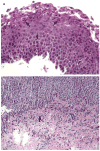High prevalence of eosinophilic esophagitis in patients with inherited connective tissue disorders
- PMID: 23608731
- PMCID: PMC3807809
- DOI: 10.1016/j.jaci.2013.02.030
High prevalence of eosinophilic esophagitis in patients with inherited connective tissue disorders
Abstract
Background: Eosinophilic esophagitis (EoE) is an emerging chronic inflammatory disease mediated by immune hypersensitization to multiple foods and strongly associated with atopy and esophageal remodeling.
Objective: We provide clinical and molecular evidence indicating a high prevalence of EoE in patients with inherited connective tissue disorders (CTDs).
Methods: We examined the rate of EoE among patients with CTDs and subsequently analyzed esophageal mRNA transcript profiles in patients with EoE with or without CTD features.
Results: We report a cohort of 42 patients with EoE with a CTD-like syndrome, representing 0.8% of patients with CTDs and 1.3% of patients with EoE within our hospital-wide electronic medical record database and our EoE research registry, respectively. An 8-fold risk of EoE in patients with CTDs (relative risk, 8.1; 95% confidence limit, 5.1-12.9; χ(2)1 = 112.0; P < 10(-3)) was present compared with the general population. Esophageal transcript profiling identified a distinct subset of genes, including COL8A2, in patients with EoE and CTDs.
Conclusion: There is a remarkable association of EoE with CTDs and evidence for a differential expression of genes involved in connective tissue repair in this cohort. Thus, we propose stratification of patients with EoE and CTDs into a subset referred to as EoE-CTD.
Keywords: BMI; Body mass index; CCHMC; CTD; Cincinnati Children's Hospital Medical Center; Connective tissue disorder; EDS; EGID; EMR; Ehlers-Danlos syndrome; Electronic medical record; EoE; Eosinophilic esophagitis; Eosinophilic gastrointestinal disorder; FBN1; Fibrillin-1 gene; GERD; Gastroesophageal reflux disease; Informatics for Integrating Biology & the Bedside; JHS; Joint hypermobility syndrome; LDS; Loeys-Dietz syndrome; MFS; Marfan syndrome; PPI; Proton pump inhibitor; connective tissue disorders; eosinophil; eosinophilic gastrointestinal disease; hypermobility syndrome; i2b2.
Copyright © 2013 American Academy of Allergy, Asthma & Immunology. Published by Mosby, Inc. All rights reserved.
Conflict of interest statement
Disclosure of potential conflict of interest: The rest of the authors declare that they have no relevant conflicts of interest.
Figures



References
-
- Liacouras CA, Furuta GT, Hirano I, Atkins D, Attwood SE, Bonis PA, et al. Eosinophilic esophagitis: updated consensus recommendations for children and adults. J Allergy Clin Immunol. 2011;128:3–20. - PubMed
-
- Kapel RC, Miller JK, Torres C, Aksoy S, Lash R, Katzka DA. Eosinophilic esophagitis: a prevalent disease in the United States that affects all age groups. Gastroenterology. 2008;134:1316–21. - PubMed
-
- Straumann A, Simon HU. Eosinophilic esophagitis: escalating epidemiology? J Allergy Clin Immunol. 2005;115:418–9. - PubMed
-
- Kelly KJ, Lazenby AJ, Rowe PC, Yardley JH, Perman JA, Sampson HA. Eosinophilic esophagitis attributed to gastroesophageal reflux: improvement with an amino acid-based formula. Gastroenterology. 1995;109:1503–12. - PubMed
-
- Spergel JM, Andrews T, Brown-Whitehorn TF, Beausoleil JL, Liacouras CA. Treatment of eosinophilic esophagitis with specific food elimination diet directed by a combination of skin prick and patch tests. Ann Allergy Asthma Immunol. 2005;95:336–43. - PubMed
Publication types
MeSH terms
Substances
Grants and funding
LinkOut - more resources
Full Text Sources
Other Literature Sources
Medical

